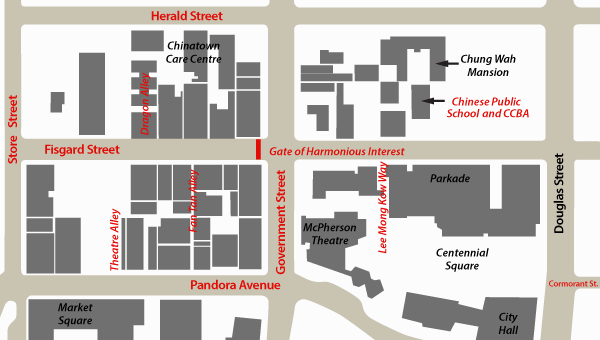- Home
- History
- Community
- Organizations
- Chinese Consolidated Benevolent Association
- Victoria Chinese Canadian Veterans Association
- Chinese Public School
- Clan Associations
- County Assocations
- Dialect Assocations
- Friendship Associations
- Political Organizations
- Recreational Associations
- Religious Organizations
- Women's Associations
- Other Organizations
- People
- Resources
- Contact
Pandora Avenue (Cormorant Street)
Yesterday's Cormorant Street and Commercial Centre of Chinatown
Victoria’s early Chinatown was centred on Cormorant Street, now known as Pandora Avenue, in the blocks between Store to the west and Douglas to the east. The Johnson Street Ravine, south of Cormorant and north of Johnson Street, acted as a barrier between Chinatown and the downtown core. A number of heritage buildings that were owned or rented by Chinese residents line Pandora Avenue. The King Tye Building is a warehouse constructed in 1887 and leased by an import-export company of that name. At the back of this building was an opium factory run by the same company. Under Chinese ownership until 1927, it was then sold to Scott and Peden, owners of a feed and grain company.
The Johnson Street Ravine, originating from a marsh near Quadra and Fort streets, was a physical divide between Chinese residents along Cormorant Street and the European-dominated city centre from Johnson Street south. Three footbridges crossed the ravine at Douglas, Government and Store streets. Chinese labourers built or rented wooden huts that projected over the northern side of the ravine, seen here in about 1890. From the 1880s, these shacks were replaced by brick commercial buildings (Royal BC Museum, BC Archives, D-04747).
Roderick Finlayson, a fur trader who helped establish Fort Victoria in 1843, invested in substantial real estate holdings in Chinatown and elsewhere in the city. He constructed the Finlayson Building at 528 Pandora in 1882. Later on, this building became Chinese-owned from 1912 to 1931, and from 1942-1990. Lum Sam and Look Dan leased the adjacent property at 534 Pandora from Finlayson from 1883 to 1909, constructing a building with decorative brickwork and a second-storey balcony there in 1883.
Cormorant Street, looking east from Store Street in 1910. From left to right are the Finlayson, Lum Sam, and Loo Chew Fan buildings (City of Victoria Archives, M05856). The second photo shows Pandora Avenue in 2012. In the foreground is the King Tye Building, followed by an empty lot, then the façade and remaining sidewalls of the Finlayson Building (Photo by Charles Yang, 2012).
The construction of several heritage buildings on Pandora served to create the narrow passageway known as Fan Tan Alley. Loo Chew Fan, the owner of a major import and export business, constructed a wide three-storey Italianate Style building on his property at 536-544 Pandora in 1884 that made up part of the western wall of the alley. In the early twentieth century, the Hoy Sun Ning Young Benevolent Association purchased this building and still has an office here among the ground floor retail stores. Forming the east wall of the alley at Pandora, the Macdonald Building was constructed in 1881 by William John Macdonald, a former Hudson’s Bay Company employee. Chinese merchants at first leased the building, and in 1908 Lim Bang, Wong Tong and Wong Yock purchased the building. In 1920, buildings were constructed behind those fronting onto Pandora, defining the narrow walkway between Pandora and Fisgard. Lee Ward and Lim Ging put up a brick building behind the Macdonald Building and behind the Loo Chew Fan Building on the west side of the alley, a two-storey brick and wood building at 4 Fan Tan Alley was constructed by Ning Young Yee Hing Tong.
Cormorant Street west of Government Street in the 1880s. In the foreground are the Loo Chew Fan Building and the Macdonald Building. The narrow gap between these buildings would become known as Fan Tan Alley (Royal BC Museum, BC Archives B-01653). The second photo shows a similar view from street level in 2012, but it is called Pandora Avenue today (Photo by Charles Yang, 2012).
Sources
“536-544 Pandora Avenue.” Canada’s Historic Places.
http://www.historicplaces.ca/en/rep-reg/place-lieu.aspx?id=3930&pid=0 (accessed 1 October 2012)
“Finlayson Building.” Canada’s Historic Places.
http://www.historicplaces.ca/en/rep-reg/place-lieu.aspx?id=14794&pid=0 (accessed 1 October 2012)
Lai, David Chuenyan. The Forbidden City within Victoria: Myth, Symbol and Streetscape of Victoria’s Earliest Chinatown. Victoria: Orca Book Publishers, 1991.
“Lum Sam and Look Den Building.” Canada’s Historic Places.
http://www.historicplaces.ca/en/rep-reg/place-lieu.aspx?id=15618&pid=0 (accessed 1 October 2012)
“Macdonald Building.” Canada’s Historic Places.
http://www.historicplaces.ca/en/rep-reg/place-lieu.aspx?id=14795&pid=0 (accessed 1 October 2012)
“Ning Young Building.” Canada’s Historic Places.
http://www.historicplaces.ca/en/rep-reg/place-lieu.aspx?id=14928&pid=0 (accessed 1 October 2012)
“Scott and Peden Building.” Canada’s Historic Places.
http://www.historicplaces.ca/fr/rep-reg/place-lieu.aspx?id=6065 (accessed 1 October 2012)


